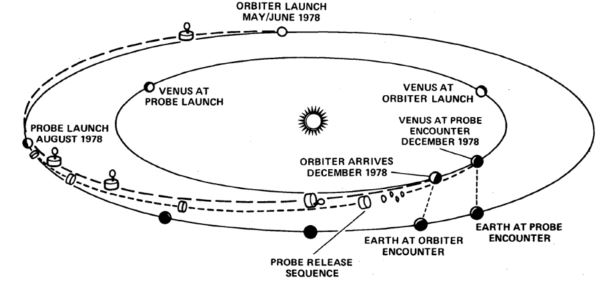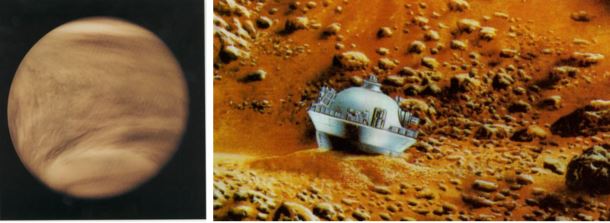Slightly smaller than Earth, Venus is our closest planetary neighbor. Despite its proximity, relatively little was known about the planet in the late 1970s, especially its lower atmosphere. All that changed, though, when the most comprehensive study of the Venusian atmosphere began 40 years ago with the Pioneer Venus project.
NASA’s Ames Research Center in California’s Silicon Valley managed the project, consisting of two spacecraft built by the Hughes Aircraft Company in El Segundo, California. Charles F. Hall (1920-1999) served as project manager until his retirement from NASA in 1980. Pioneer Venus Orbiter remotely gathered information to analyze Venus’ atmosphere using a suite of instruments while Pioneer Venus Multiprobe deployed several entry probes to collect data on the atmosphere from the cloud tops all the way down to the surface at several sites around the planet. In 1972, a NASA Science Steering Committee listed 24 important scientific questions at the forefront of Venus research, and the Pioneer Venus project addressed 23 of them. A total of 114 scientists were associated with the project, representing 34 colleges and universities, 14 federal laboratories and 15 industrial laboratories, as well as 10 foreign countries.
Beginning in 1962, several spacecraft had visited Venus to try to unlock some of its secrets. Three American spacecraft (Mariner 2, 5, and 10) made brief fly-bys of the planet and eight Soviet spacecraft attempted to land on it, with only the last four achieving that goal. One reason for the difficulty in the landing attempts was Venus’ atmosphere. At the surface, temperatures reach 900o F and pressures are more than 90 times higher than at Earth’s sea level – the equivalent of being more than half a mile under water. The thick atmosphere, composed of more than 96% carbon dioxide with clouds of sulfuric acid, prevents a direct view of the planet’s surface.
Pioneer Venus Orbiter launched first on May 20, 1978. Mission planners chose a 7-month trajectory to Venus that ensured a slower speed when the spacecraft arrived at its destination, thereby saving fuel required for the orbit insertion burn. Pioneer Venus Multiprobe launched on Aug. 8, and took a shorter 4-month path to Venus, ensuring arrival just days after the Orbiter. The Soviet Union also took advantage of this launch opportunity to dispatch two spacecraft to explore Venus. Venera 11 and 12, launched Sep. 9 and 14, respectively, were two-part spacecraft each made up of a flyby bus and a softlander. They were follow-ons to the highly successful Venera 9 and 10 that orbited and made soft landings on Venus in 1975, returning the first photographs from the surface of the planet. When all components are counted, a fleet of 10 spacecraft were on their way to Venus in the fall of 1978.
The encounter sequence for the Pioneer Venus spacecraft began on Nov. 16, when the Multiprobe Bus released the Large Probe, followed four days later by the three Small Probes, called Day, Night, and North for their planned destinations on the planet’s surface. The probes were not expected to function after making contact with the surface. On Dec. 4, Pioneer Venus Orbiter entered an elliptical orbit around the planet to begin its mission expected to last one Venusian “day”, or about 243 Earth days. Five days later, the Large Probe made its entry into Venus’ atmosphere on the planet’s day side near the equator, returning data until impact with the surface. Minutes later, the three Small Probes made their respective entries into the atmosphere, relaying data as they fell toward the surface. Amazingly, two of the probes survived touchdown and continued to return data from the surface – Night Probe for just 2 seconds (it likely tipped over after landing) and Day Probe for 68 minutes. Finally, the Multiprobe spacecraft Bus of burned up as expected at an altitude of 75 miles, providing data for 2 minutes on the planet’s upper atmosphere.
The two Veneras made almost identical approaches to Venus, with Venera 12 arriving first on Dec. 21 and Venera 11 four days later. Two days before their encounters, the main spacecraft released their landers that made independent descents through the atmosphere while the buses flew by Venus and continued on into solar orbit. Venera 12 transmitted data from the surface for 110 minutes and Venera 11 for 95 minutes. Unfortunately, the lens covers on both spacecraft’s cameras failed to jettison and no color photographs of the surface could be obtained. The soil chemistry analyzer on both landers also failed to operate. The landers did return much useful information about conditions at the planet’s surface from their landing sites 500 miles apart.
The Pioneer Venus spacecraft provided a detailed and accurate picture of Venus’ atmosphere, the thick cloud layers, and the wind systems. While the Multiprobe’s mission was brief once it arrived at Venus, the Orbiter far outlasted its expected 243-day lifetime. Although its nominal mission ended August 4, 1979, extensions allowed it to continue taking measurements of the planet for 14 years. The ultraviolet light photographs it took showed dark markings in Venus’ cloud tops, and it detected radio signals from the planet revealing almost continuous lightning activity in the atmosphere. The radar experiment mapped 93% of the planet’s surface, revealing its topography to be more similar to Earth’s, with high features similar to mountains and extensive relatively flat areas, than the cratered surfaces of the Moon, Mercury, and Mars.
During its years of operation, scientists used the spacecraft’s ultraviolet spectrometer to study seven comets, including Comet Halley in 1986, as they made their passage through the inner solar system. On October 2, 1992, its fuel reserves depleted, Pioneer Venus Orbiter burned up on entry in Venus’ atmosphere, having completed 5,055 orbits around the planet. By that time, NASA’s Magellan spacecraft had joined it in orbit around Venus for its radar-mapping mission to continue uninterrupted observations of our planetary neighbor.
The two Venera landers confirmed the nearly 900o F temperature at Venus’ surface, and during their descent also found evidence for lightning in the atmosphere. The overall findings from the missions confirmed that a strong greenhouse effect from the dense carbon dioxide atmosphere is responsible for the extremely high temperatures at the planet’s surface.
For more on the Pioneer Venus project, please see this NASA Ames documentary: https://www.youtube.com/watch?v=LaGH6dE2bpE






























